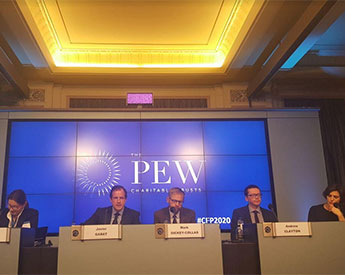|

Conference held yesterday in Brussels with the support of environmental organization Pew. (Photo: Cepesca)
Fishing sector demands more realism and flexibility from EU
 EUROPEAN UNION EUROPEAN UNION
Thursday, February 22, 2018, 21:20 (GMT + 9)
The Secretary General of CEPESCA and President of Europêche, Javier Garat, has exposed the challenges facing the EU fishing sector due to the rigid requirements set by the Common Fisheries Policy to achieve the maximum sustainable yield (MSY) by 2020, the landing obligation and the uncertainty that Brexit is creating.
The combination of all these factors, known in the sector as "the perfect storm", were exposed by Garat at the conference "How far has the EU come in ending overfishing?", held yesterday in Brussels with the impulse of the environmental organization Pew.
During his speech, Garat also assessed the progress made in improving the stock state as a result of the efforts made by the EU fishing sector. In this regard, he stressed that this increase is not a coincidence or a lucky incident, but the result of the many efforts made by the fishing sector, starting with constrained TACs that have caused a significant reduction in fleets and employment in the European fishing sector.
"The fishing sector agrees with the European Commission on the need to achieve the maximum number of stocks in MSY as soon as possible, but not at any price and without taking socioeconomic factors into consideration," said Garat.
"Even NGOs are aware of the impossibility of reaching an MSY level for all stocks simultaneously," he stressed.
Under this premise, the European fishing sector considers that the EU should establish TACs for each of the fisheries in accordance with the best possible scenario to guarantee sustainable fishing activity from the environmental point of view, but without forgetting the social and economic aspects. This approach will achieve the objectives of the Common Fisheries Policy (CFP) progressively in a reasonable period of time.
Cepesca recalls - and this is confirmed by the data of the International Council for the Exploration of the Sea (ICES) -, which in recent years has seen remarkable progress in the state of fish stocks, from 5 stocks at MSY in 2009 to 53 in 2018 in the Northeast Atlantic. However, and despite the fact that the available data have increased substantially, insufficient data of 45 percent of the stocks are available, so it is necessary to improve the process of gathering information and processing the data by scientists.
On the other hand, and as shown by the ICES assessments, which since 1980 have covered 90 percent of the total catches in the Northeast Atlantic reported to FAO, only four of these species (herring, cod, mackerel and capelin) represent more than 50 percent of the catches (in weight), while 14 species and 50 species constitute 80 percent and 95 percent of the historical catches, respectively. Given this reality, the fishing sector considers it more realistic to focus the efforts to achieve the MSY in 2020 of the main target species, instead of trying to cover, in such a tight time frame, the totality of the stocks.
On the other hand, the representative of the European Commission stressed that 97 percent of the stocks, depending on the landings, managed by the EU alone, are fulfilling the objective of the MSY.
editorial@seafood.media
www.seafood.media
|
|



